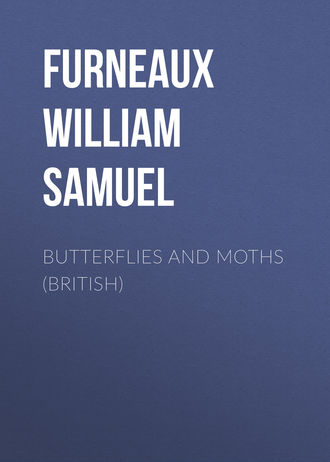 полная версия
полная версияButterflies and Moths (British)
We commence with one of the brightest members of the family, the Frosted Orange. Its fore wings are dark yellow or ochreous, with distinct brown markings, the chief of which are two broad transverse bands. The orbicular spot is pale yellow and very distinct. The hind wings are dingy yellow. This moth flies from July to September, and is easily attracted by a light at night. It is common everywhere.
The larva is yellow, dotted with black, with a brownish plate on the second segment. It feeds inside the stems of a number of plants, including the marsh thistle (Cnicus palustris), musk thistle (Carduus nutans), burdock (Arctium minus), mullein (Verbascum thapsus), foxglove (Digitalis purpurea), and elder (Sambucus nigra). When about to change to the chrysalis it eats nearly to the surface of the stem, leaving only a very thin and transparent layer of the epidermis to cover the hole through which it is to escape when it becomes a moth.
The caterpillars are to be found in June, and the chrysalides in July.
The Flame (Axylia putris)This also is a pretty insect, but much smaller than Ochracea. It is common in most parts, and may be seen flying in weedy and waste grounds at dusk during June and July.

Fig. 147. – The Flame.
The fore wings are pale pinkish brown, with dark brown along the costa, and two patches of the same colour on the hind margin. There is also a double line of small brown dots parallel with the hind margin.
The larva is brown, with one yellow and two white dots on each segment. There is also a triangular dark patch on each of the fifth and sixth segments. It feeds during August on the stinging nettle (Urtica dioica), and various other low herbs.
The Light Arches (Xylophasia lithoxylea)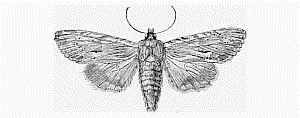
Fig. 148. – The Light Arches.
The fore wings of this species are very light ochreous, with a light brown patch on the middle of the costa, and patches of the same colour along the hind margin; also a row of small black dots parallel with the same margin. The hind wings are pale ochreous: they are brownish along the hind margin, and have a light fringe.
The moth is very common in waste places, and flies in June and July.
The caterpillar is of a dirty white colour, dotted with black, and has a black head. It feeds on the roots of grasses in May.
The Flounced Rustic (Luperina testacea)
Fig. 149. – The Flounced Rustic.
The fore wings are greyish brown, with darker umber-brown markings. These latter are variable, but the most conspicuous is a series of dark crescent-shaped spots almost parallel with the hind margin, and immediately outside these is a series of paler crescents.
The caterpillar is dull flesh-colour, with a brown head, and a brownish plate on the second segment. It feeds on the stems of grasses.
The moth is common throughout the British Isles, and flies in August and September.
The Cabbage Moth (Mamestra Brassicæ)Whatever be your methods of moth collecting, you are sure to meet with Brassicæ in abundance. They swarm round the insect hunter's sugar in such numbers as to become a positive nuisance. They are also attracted by light. During the day they may be seen at rest on palings. The caterpillar is even better known, and with reason, for it is fearfully destructive to our vegetables and even our flower beds. It burrows into the hearts of cabbages, filling the galleries it makes with its excrement, often leaving no very visible outward signs of its presence within. But its ravages are by no means confined to cabbages. It eats with more or less relish almost every vegetable and flowering plant of our gardens, and is equally partial to the various herbs of the field.

Fig. 150. – The Cabbage Moth.
The fore wings of the moth are dingy brownish grey, marbled in a very confused manner by darker markings. The reniform spot is very distinct, the orbicular less so. A light zigzag line runs parallel with the hind margin. It flies in June and July.
The larva feeds later in the season, and changes to the chrysalis beneath the soil in the autumn. It is of a dark grey colour, with a darker line on the back, and a lighter one along the spiracles, which are white.
The Dot (Mamestra Persicariæ)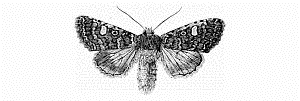
Fig. 151. – The Dot.
The conspicuous white reniform spot on the very dark marbled fore wings is always sufficient for the identification of this species.
This moth is out in June and July; and during the latter month lays its eggs on the elder (Sambucus nigra), and the various low plants that supply the larva with food.
The larva is greenish or greyish, sometimes with a reddish tinge, with a light line down the back. The twelfth segment is humped, and there are dark V-shaped marks on the back of segments five to twelve inclusive. It is full grown in September, and burrows into the ground to undergo its change to the chrysalis, in which state it remains throughout the winter.
The Rustic Shoulder-knot (Apamea basilinea)
Fig. 152. – The Rustic Shoulder knot.
The fore wings of this species are pale ochreous grey, with light brown markings; and there is a short dark streak in the middle of the base, from which feature the specific name (Basilinea) is derived. The hind wings are of a similar colour, but shading into a dark smoke colour at the hind margin.
The caterpillars feed at first on the grains of wheat, on the ears of which the moth deposits the eggs in June. At harvest time they remain hidden among the husks, and are often threshed out in large numbers by the blows of the flail. The cold weather soon overtakes them, and they then spin a cocoon in which to pass the winter. On the approach of spring they come out again, and feed by night on various low plants, hiding themselves among the roots by day. In March they are full grown, and change to brown chrysalides beneath the surface of the ground.
The moth flies in June, and is one of the commonest and most destructive of our Noctuæ.
The Marbled Minor (Miana strigilis)The next three genera (Miana, Phothedes, and Celæna) include seven small moths known as the 'Minors.' The commonest of them is the Marbled Minor, which is to be found in abundance everywhere during June and July.

Fig. 153. – The Marbled Minor.
This species is very variable, but the fore wings are usually dark brown, marbled with a lighter colour – white or grey. There is generally an irregular white or pale grey band crossing the wings parallel with the hind margin, and two white marks on the inner margin, halfway between this band and the base. There is also a deep black blotch across the middle of the wing.
The caterpillar is greyish or greenish with paler lines and black spiracles. It feeds on grasses in March and April, and changes to a chrysalis under the ground in May.
Family – CaradrinidæThere are only ten British species in this family, two of which are rare; and most of the others are particularly dingy. The transverse lines so often seen on the fore wings of Noctuæ are generally well marked. The larvæ have short stiff bristles, and feed on low plants; they undergo their changes in an earthen cocoon under the ground.
The Mottled Rustic (Caradrina Morpheus)We select as our type of this family the Mottled Rustic – a common moth that may be procured from June to August. Its fore wings are brownish grey, with darker lines and spots; the hind wings are almost white, but darker at the tip.

Fig. 154. – The Mottled Rustic.
The caterpillar is brownish grey, with a row of triangular spots on each side of the back. It is very sluggish, spending the greater part of its existence among the roots of low plants. It feeds throughout the winter, except during severe weather, and is full grown in April. The food plants include teasels (Dipsacus pilosus and D. sylvestris), hedge bedstraw (Galium Mollugo), orpine (Sedum Telephium), sallows (Salix), and various other plants.
The chrysalis may be dug out in May.
Family – NoctuidæA glance at our list of British Noctuæ (Appendix I) will show that this family contains nearly fifty species and only three genera. It includes several very common moths that frequent our gardens and are to be met with during almost every summer evening ramble.
Most of the species are very dingy, but the half-dozen that comprise the genus Triphæna are characterised by the bright colouring of the hind wings. The fore wings are narrow and more or less glossy, and overlap to a greater or less extent when the insects are at rest; and the hind wings are folded and completely hidden beneath them.
The larvæ are rather thick and smooth, and generally of very dingy colours. They feed on low plants, often confining their ravages to the roots, and generally lie well concealed close to the ground or under the surface.
The pupæ are brown, smooth, and shining, and are usually inclosed in earthen cocoons.
We shall briefly notice a few members of each of the three genera.
The Turnip Moth (Agrotis Segetum)This is another of those destructive insects that attack vegetable and flower gardens, often doing so much damage to our crops as to become quite a nuisance to cultivators.

Fig. 155. – The Turnip Moth.
The moth is decidedly dingy. Its fore wings are brown, clouded with a darker tint. The hind wings are almost white, sometimes with a brown hind margin.
In June it lays its eggs on the stems of young plants, generally very close to the ground. As soon as the young caterpillars emerge they commence feeding on the lower parts of the stems, or burrowing deeply into the larger succulent roots. When the larvæ have completed their work of destruction in this way, they change to brown chrysalides in the ground. Some undergo this change in October, and shortly after give rise to a second brood of moths; but most of them remain in the caterpillar state throughout the winter, and, contrary to the general rule with hybernating larvæ, continue to feed almost throughout the winter months, and change to the chrysalis in the following May.
The caterpillar grows to a large size. It is of a greyish or greenish colour, with a paler line on the back, a light brown line on each side of this, black spots between these lines, and black spiracles.
The Heart and Dart (Agrotis Exclamationis)The destructive work of Segetum is assisted by similar operations of the Heart and Dart, the larva of which feeds voraciously on the roots of several of our cultivated vegetables, though the present species does not entirely confine its ravages to the farmer's crops, but attacks the roots of many low-growing herbs.
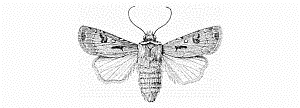
Fig. 156. – The Heart and Dart.
The fore wings of the moth are light brown, generally with a reddish tinge. The darker markings include a large and very distinct reniform spot, a less distinct orbicular, and a conspicuous longitudinal blackish streak near the base of the wing known as the claviform. Beyond the reniform a curved and zigzag dark line crosses the wing. The hind wings of the male are very pale, those of the female darker, with a whitish fringe.
The moth flies from June to August, and is common everywhere. The caterpillar feeds in the autumn, and reaches its full size in October; but it is said to feed at intervals throughout the winter. Its colour is dingy brown or grey, with paler lines on the sides. The spiracles are black, and there are black dots on the sides.
The Garden Dart (Agrotis nigricans)This is another dingy moth, whose general appearance is so unattractive that the tyro might be inclined to neglect it. But it must not be omitted from our selection on that score, for our main object here is to give the beginner an acquaintance with those species that are most likely to be captured in the earlier part of his career, and this moth is certainly one of those that may be described as 'abundant everywhere.'

Fig. 157. – The Garden Dart.
Its fore wings are dull dark brown, often tinged with red, and clouded with black. The reniform spot is pale, the orbicular spot less distinct, and between the two there is generally a rhomboidal dark spot. There is also a short dark streak near the base of the wing, and a black spot before the orbicular. The hind wings are pale, but smoky towards the hind margin.
The caterpillar is brown and shining, with a fine pale line on the back, and a double white stripe below the spiracles. It is also dotted with black. It is exceedingly destructive, feeding on clovers (Trifolium pratense and T. repens) and various low plants in May and June.
The moth flies from June to August.
The Flame Shoulder (Noctua plecta)
Fig. 158. – The Flame Shoulder.
As our example of the next genus we take the Flame Shoulder, a rather small moth, easily identified by the broad yellowish-white streak along the costa of the reddish-brown fore wings. The orbicular and reniform spots are margined with white, and a thin white streak runs from the base of the wing to the former. The hind wings are white. This moth flies in July, and is common throughout Great Britain.
The caterpillar is reddish brown, with a slender line of white dots on the back, and a similar line on each side. The body is smooth and velvety, and is netted and dotted all over with dark brown. It feeds on the lady's bedstraw (Galium verum), sweet woodruff (Asperula odorata), and many other low plants; and is full fed early in July.
The Lesser Broad Border (Triphæna ianthina)We now come to the third and last genus (Triphæna) of this extensive family, a genus which includes six interesting moths, with bright orange or yellow hind wings. Of these we shall take three examples.

Fig. 159. – The Lesser Broad Border.
The first of them – the Lesser Broad Border – has fore wings of a rich reddish or violet brown, with paler markings. The hind wings are bright orange, with a broad marginal band of black.
It is a common moth, particularly in the south-western counties, and flies during July and August.
The caterpillar is of a dingy yellowish or greenish grey, with a light line down the back, and two black spots on each side of segments nine to twelve inclusive. It feeds throughout the winter by night on dead nettles (Lamium purpureum and L. album), primrose (Primula acaulis), whitethorn (Cratægus oxyacantha), blackthorn (Prunus spinosa), and various low plants; and may sometimes be seen in flower gardens. It is full grown in April.
The Lesser Yellow Underwing (Triphæna Comes)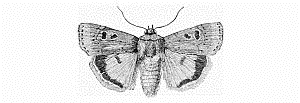
Fig. 160. – The Lesser Yellow Underwing.
This insect is very similar to the last, but is larger. The fore wings are also of a greyish or ochreous brown, and the black margin of the hind wings is proportionately narrower.
It is more abundant than Ianthina; in fact it is to be found everywhere in plenty during the month of July.
The caterpillar is yellowish brown. On the back of each of the eleventh and twelfth segments are two conspicuous dark marks. The spiracles are white, and below them is a pale brown stripe. It feeds on the foxglove (Digitalis purpurea), chickweed (Stellaria media), thrift (Armeria maritima), and other low plants in the autumn, hybernates during the winter, and attacks sallows (Salix Caprea and S. cinerea) and whitethorn (Cratægus oxyacantha) as soon as the buds appear in the spring. It is full grown in April, and then changes to a chrysalis on the surface of the earth.
The Large Yellow Underwing (Triphæna Pronuba)This is by far the commonest moth of the genus, and may be found everywhere, in town and country, from June to August. It is represented on Plate XI (fig. 1), but its fore wings are very variable, sometimes a cold dingy grey, but often of an exceedingly rich and warm brown. On the costal margin, not far from the tip, there is always a small black spot, which will serve to distinguish it from Comes.
The caterpillar (fig. 21) feeds throughout the winter on the roots of almost every plant in our gardens; and, during the warmer weather of the autumn and spring, on stems and leaves. It is full grown early in the summer, and then changes to a chrysalis in the ground. Its colour is dirty yellowish or greenish grey, with a row of dark spots on each side.
Family – AmphipyridæThe Gothic (Mania typica)The above family contains only four British species, two of which we shall briefly consider.
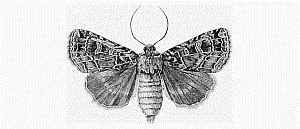
Fig. 161. – The Gothic.
The first of these is the Gothic – a very common moth that may be seen everywhere about midsummer. Its fore wings are brown with darker marblings, and there are numerous lighter markings which may be easily made out by reference to the accompanying woodcut.
The caterpillar is smooth and velvety, of a dull brown or greenish colour, with darker dorsal and side stripes. The latter are crossed obliquely by a series of whitish lines. It feeds on fruit and other trees in clusters when very young in early autumn, and afterwards descends and feeds on low plants. It hybernates in the winter, and feeds again on low plants in the spring. When full grown it burrows into the soil to undergo its changes.
The Old Lady (Mania Maura)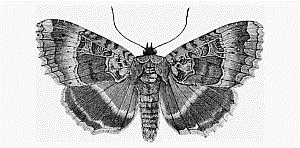
Fig. 162. – The Old Lady.
This fine moth is so very different from the last in appearance that the reason for placing the two in the same genus is not apparent till the earlier stages and life history have been studied. All its wings are very deep brown; the front pair has a darker band containing the orbicular and reniform spots, and the hind pair a lighter band across the middle.
It is a common moth, often to be found at rest by day in outhouses and sheds. It flies in July and August.
The caterpillar is dark purple or umber brown, with darker and lighter markings. It feeds in the autumn on fruit trees, and hybernates during the winter. In the spring it feeds again on low plants, and changes to a chrysalis in May under the ground.
Family – OrthosiidæThis is a large family of over thirty species, most of them of rather small size, which make their appearance, with two exceptions, either in early spring or in late autumn, often attracted in the former season by the sallow blossom, and in the latter by ivy bloom.
Several of them are very common insects, that are almost sure to be taken by a young collector during his first season.
The fore wings of these moths are more or less pointed at the tip, and the usual lines and spots are generally distinct. The males may be distinguished from the females by their antennæ, which are always more or less ciliated.
The caterpillars are smooth and velvety, and feed by night; and the pupæ are inclosed in cocoons constructed of earth and silk.
The Common Quaker (Tæniocampa stabilis)Several of the species of the family are known popularly as Quakers, the commonest of which —Stabilis– is abundant in all parts.

Fig. 163. – The Common Quaker.
Its fore wings are grey, with generally either an ochreous or reddish tinge. The orbicular and reniform spots are outlined with a paler colour, and there is a pale transverse line parallel with the hind margin, outside which is a row of indistinct black spots. The hind wings are greyish brown.
The caterpillar is green and velvety, with a yellowish line on the back and on each side; and a yellow band crosses the back of the twelfth segment transversely. It feeds during June and July on oak (Quercus Robur) and elm (Ulmus campestris), and changes to a chrysalis in August on the surface of the ground. In this state it remains throughout the winter, and the moth emerges in March or April.
The Chestnut (Cerastis Vaccinii)Unfortunately our space will not allow us to notice the whole of even the very common moths, so, passing over a few with great reluctance, we come to the familiar Chestnut, which may be seen at large in October and November, and sometimes even in December, and again appears, after a rather short period of hybernation, in February and March.

Fig. 164. – The Chestnut.
The fore wings are reddish brown, with darker wavy lines. The orbicular and reniform spots have pale outlines, and the lower half of the latter is very dark grey. The hind wings are smoky grey, with generally a pale band beyond the middle.
The caterpillar is dark brown, with very indistinct lighter lines. The spiracles are black, and inclosed in a yellowish grey stripe. It feeds during June and July on the elm (Ulmus campestris), oak (Quercus Robur), and sallow (Salix caprea), and various low plants.
The Pink-barred Sallow (Xanthia Flavago)This moth is not nearly so common as the preceding species, but has been taken more or less in all parts of England.

Fig. 165. – The Pink-barred Sallow.
Its fore wings are orange yellow, with purplish markings arranged as represented in fig. 165. The hind wings are yellowish white.
The caterpillar is brown, with a lateral stripe formed by numerous red, yellow and white dots. It feeds on sallow (Salix caprea) and various low plants.
It is full grown in June, and the moth appears in September.
Family – CosmiidæThe Dun-bar (Calymnia trapezina)Our example of this family is the Dun-bar, common everywhere during July and August.

Fig. 166. – The Dun-bar.
Its fore wings are greyish ochreous, with a darker band across the middle. On each side of this band is a white line margined with dark grey, and there is a row of black spots along the hind margin. The hind wings are smoky brown, becoming paler towards the base.
The caterpillar feeds on oak (Quercus Robur), hornbeam (Carpinus Betulus), and birch (Betula alba), and may be found in abundance during May and June. It is green, with dark spots, and white lines on the back and sides. Although it partakes of the leaves of the above-named trees, yet its chief food seems to be other caterpillars, for it devours these with a savage greediness that is simply astonishing. It will chase an unfortunate caterpillar, seize it by the neck with a fatal grip, and rapidly devour it. Its chief prey seems to be the larva of the Winter Moth (Brumata).

